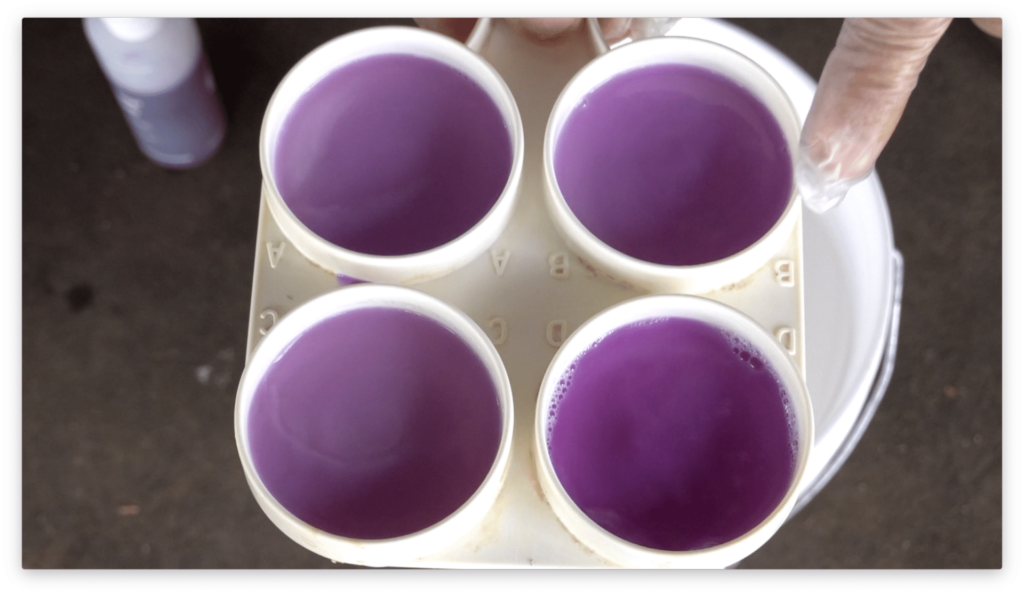Learn how to test your family milk cow for mastitis using the California Mastitis Test.
If you own a dairy cow chances are at some point you will deal with udder issues. This is a part of dairying, and today I am giving you a few tips that will help you mitigate and hopefully avoid problems. I will discuss how to test your family milk cow for mastitis and some guidelines for using the California Mastitis Test (CMT). The CMT is an inexpensive, easy to use at home test for early detection of mastitis.
For a demonstration on how to test your milk cow for mastitis, watch our video:
4 Signs That You May Need to Perform A Mastitis Test On Your Cow
- Slow straining milk
- After straining the milk you see milk curds, a yellowish film, anything out of the norm
- Salty tasting milk
- If your cheese making fails the first place to look is the milk! I make kefir every 24 hours and it will fail if the milk is off. Even if the milk has a trace result on the CMT the kefir will be off.
Factors that may influence your CMT result
- Estrus in the cow
- Stage of lactation; for instance, our cows might have a positive result the first week after calving. You may also see some CMT reaction in late lactation
- Age of the cow: The older the cow, the more likely she is to have a positive result.
- Environmental factors
- Failure to follow the directions; for example, failing to only strip out the first stream of milk will affect the results of the CMT.
 HOW TO USE THE CALIFORNIA MASTITIS TEST
HOW TO USE THE CALIFORNIA MASTITIS TEST
- Mix your reagent by following the directions that come with the kit.
- Wash the paddle that came in the kit.
- Gather CMT and udder cleaning supplies. REMEMBER IT IS A GOOD IDEA TO WEAR GLOVES!
- Clean the cow’s udders. You can watch our “WATCH US MILK A COW BY HAND” to see how we clean our cow’s udders.
- Strip out one stream of milk from each quarter.
- Milk 1-2 teaspoons of milk into each cup of the white paddle.
- Tilt the paddle and let the milk empty out until even with the outside circle.
- Level out the paddle until the milk line is halfway between the outer and inner circle.
- Add the reagent until liquid is even with the inner circle. The goal is to have equal amounts of milk and reagent.
- Flatten the paddle to horizontal position and gently rotate for up to 10 seconds. After 10 seconds the result disintegrates. Discard in container to avoid contamination.
- See the chart provided with the CMT kit for grading the reaction. Basically, the thickness of the liquid indicates the stage of mastitis. When the mixture is a thin liquid, the test is negative.
- If you see a positive result it is best to call your vet.
IF YOU GET A POSITIVE RESULT MAKE SURE TO CHANGE GLOVES AFTER MILKING THE INFECTED QUARTER TO AVOID SPREADING MASTITIS. YOU SHOULD MILK THE HEALTHY QUARTERS FIRST, THEN MILK THE INFECTED QUARTER LAST TO AVOID SPREADING TO CLEAN QUARTERS.
Early detection is the key to slowing down the progression of the infection. Consult with your vet to formulate a plan. Your vet will probably culture the infected quarter to specify the type of mastitis. There are numerous kinds of mastitis and each may require a different therapy.
A FEW TIPS THAT HELP US AVOID MASTITIS
- Allowing the cow and calf to run together will allow the calf to nurse more frequently. This ensures the quarter is frequently milked out, which helps alleviate the mastitis.
- The infected quarter needs to be completely milked out at least twice daily.
- With even the smallest reaction we alter the cow’s diet.
- We feed the cow a herb mastitis mix and massage the infected quarter with peppermint balm.
- Hand milking is gentler on the udder than machine milking, try this!
- Avoid allowing other calves nursing the positive cow then nursing their mother.
- Our calves are born in the spring. This allows the cow to lactate in seasons where she can eat green grass. We don’t have calves born in the winter when the weather is wet and cold because cow’s udders can get frost bite!
- Our cows are kept in pastures without standing water.
- We test our milk cow for mastitis at least once a week just for a bit of extra insurance. When it comes to mastitis prevention remember early detection is key!
ONE FACTOR WE STRESS IN MANAGING OUR MILK COWS IS PROVIDING A STRESS-FREE ENVIRONMENT. LIKE US, THEY RELY ON A HEALTHY IMMUNE SYSTEM FOR VIBRANT HEALTH. STRESS CAN MAKE US ILL AND STRESS CAN MAKE A COW MORE PRONE TO ILLNESS. KEEP THIS IN MIND AND YOU WILL BE SURPRISED HOW AMAZINGLY HEALTHY YOUR COWS ARE! I WILL SHARE ON THE BLOG SOME OUR TRIED AND TRUE TECHNIQUES THAT WORK FOR US SO STAY TUNED!







